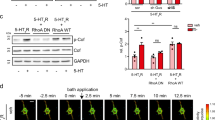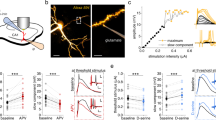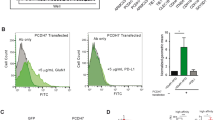Abstract
Communication between glial cells and neurons is emerging as a critical parameter of synaptic function. However, the molecular mechanisms underlying the ability of glial cells to modify synaptic structure and physiology are poorly understood. Here we describe a repulsive interaction that regulates postsynaptic morphology through the EphA4 receptor tyrosine kinase and its ligand ephrin-A3. EphA4 is enriched on dendritic spines of pyramidal neurons in the adult mouse hippocampus, and ephrin-A3 is localized on astrocytic processes that envelop spines. Activation of EphA4 by ephrin-A3 was found to induce spine retraction, whereas inhibiting ephrin/EphA4 interactions distorted spine shape and organization in hippocampal slices. Furthermore, spine irregularities in pyramidal neurons from EphA4 knockout mice and in slices transfected with kinase-inactive EphA4 indicated that ephrin/EphA4 signaling is critical for spine morphology. Thus, our data support a model in which transient interactions between the ephrin-A3 ligand and the EphA4 receptor regulate the structure of excitatory synaptic connections through neuroglial cross-talk.
This is a preview of subscription content, access via your institution
Access options
Subscribe to this journal
Receive 12 print issues and online access
$209.00 per year
only $17.42 per issue
Buy this article
- Purchase on Springer Link
- Instant access to full article PDF
Prices may be subject to local taxes which are calculated during checkout







Similar content being viewed by others
References
Salzer, J.L. Clustering sodium channels at the node of Ranvier: close encounters of the axon-glia kind. Neuron 18, 843–846 (1997).
Ventura, R. & Harris, K.M. Three-dimensional relationships between hippocampal synapses and astrocytes. J. Neurosci. 19, 6897–6906 (1999).
Araque, A., Parpura, V., Sanzgiri, R.P. & Haydon, P.G. Tripartite synapses: glia, the unacknowledged partner. Trends Neurosci. 22, 208–215 (1999).
Haydon, P.G. GLIA: listening and talking to the synapse. Nat. Rev. Neurosci. 2, 185–193 (2001).
Ullian, E.M., Sapperstein, S.K., Christopherson, K.S. & Barres, B.A. Control of synapse number by glia. Science 291, 657–661 (2001).
Murai, K.K. & Pasquale, E.B. Can Eph receptors stimulate the mind? Neuron 33, 159–162 (2002).
Pasquale, E.B. The Eph family of receptors. Curr. Opin. Cell Biol. 9, 608–615 (1997).
Ethell, I.M. et al. EphB/syndecan-2 signaling in dendritic spine morphogenesis. Neuron 31, 1001–1013 (2001).
Dalva, M. et al. EphB receptors interact with NMDA receptors and regulate excitatory synapse formation. Cell 103, 945–956 (2000).
Takasu, M.A., Dalva, M.B., Zigmond, R.E. & Greenberg, M.E. Modulation of NMDA receptor-dependent calcium influx and gene expression through EphB receptors. Science 295, 491–495 (2002).
Dunaevsky, A., Tashiro, A., Majewska, A., Mason, C. & Yuste, R. Developmental regulation of spine motility in the mammalian central nervous system. Proc. Natl. Acad. Sci. USA 96, 13438–13443 (1999).
Dunaevsky, A., Blazeski, R., Yuste, R. & Mason, C. Spine motility with synaptic contact. Nat. Neurosci. 4, 685–686 (2001).
Yuste, R. & Bonhoeffer, T. Morphological changes in dendritic spines associated with long-term synaptic plasticity. Annu. Rev. Neurosci. 24, 1071–1089 (2001).
Harris, K.M. & Kater, S.B. Dendritic spines: cellular specializations imparting both stability and flexibility to synaptic function. Annu. Rev. Neurosci. 17, 341–371 (1994).
Kaufmann, W.E. & Moser, H.W. Dendritic anomalies in disorders associated with mental retardation. Cereb. Cortex 10, 981–991 (2000).
Glantz, L.A. & Lewis, D.A. Decreased dendritic spine density on prefrontal cortical pyramidal neurons in schizophrenia. Arch. Gen. Psychiatry 57, 65–73 (2000).
Zhang, J.H., Cerretti, D.P., Yu, T., Flanagan, J.G. & Zhou, R. Detection of ligands in regions anatomically connected to neurons expressing the Eph receptor Bsk: potential roles in neuron-target interaction. J. Neurosci. 16, 7182–7192 (1996).
Martone, M.E., Holash, J.A., Bayardo, A., Pasquale, E.B. & Ellisman, M.H. Immunolocalization of the receptor tyrosine kinase EphA4 in the adult rat central nervous system. Brain Res. 771, 238–250 (1997).
Henderson, J.T. et al. The receptor tyrosine kinase EphB2 regulates NMDA-dependent synaptic function. Neuron 32, 1041–1056 (2001).
Gerlai, R. & McNamara, A. Anesthesia induced retrograde amnesia is ameliorated by ephrinA5-IgG in mice: EphA receptor tyrosine kinases are involved in mammalian memory. Behav. Brain Res. 108, 133–143 (2000).
Gerlai, R. Eph receptors and neural plasticity. Nat. Rev. Neurosci. 2, 205–209 (2001).
Mann, F., Ray, S., Harris, W. & Holt, C. Topographic mapping in dorsoventral axis of the Xenopus retinotectal system depends on signaling through ephrin-B ligands. Neuron 35, 461–473 (2002).
Flanagan, J.G. & Vanderhaeghen, P. The Ephrins and EPH receptors in neural development. Annu. Rev. Neurosci. 21, 309–345 (1998).
Stein, E. et al. A role for the Eph ligand ephrin-A3 in entorhino-hippocampal axon targeting. J. Neurosci. 19, 8885–8893 (1999).
Lai, K.O., Ip, F.C. & Ip, N.Y. Identification and characterization of splice variants of ephrin-A3 and ephrin-A5. FEBS Lett. 458, 265–269 (1999).
Pasini, A. & Wilkinson, D.G. Stabilizing the regionalization of the developing vertebrate central nervous system. Bioessays 24, 427–438 (2002).
Bushong, E.A., Martone, M.E., Jones, Y.Z. & Ellisman, M.H. Protoplasmic astrocytes in CA1 stratum radiatum occupy separate anatomical domains. J. Neurosci. 22, 183–192 (2002).
Davenport, R.W., Thies, E., Zhou, R. & Nelson, P.G. Cellular localization of ephrin-A2, ephrin-A5, and other functional guidance cues underlies retinotopic development across species. J. Neurosci. 18, 975–986 (1998).
Pak, D.T., Yang, S., Rudolph-Correia, S., Kim, E. & Sheng, M. Regulation of dendritic spine morphology by SPAR, a PSD-95-associated RapGAP. Neuron 31, 289–303 (2001).
McCall, M.A. et al. Targeted deletion in astrocyte intermediate filament (Gfap) alters neuronal physiology. Proc. Natl. Acad. Sci. USA 93, 6361–6366 (1996).
Korkotian, E. & Segal, M. Structure–function relations in dendritic spines: is size important? Hippocampus 10, 587–595 (2000).
Chelly, J. Breakthroughs in molecular and cellular mechanisms underlying X-linked mental retardation. Hum. Mol. Genet. 8, 1833–1838 (1999).
Shamah, S.M. et al. EphA receptors regulate growth cone dynamics through the novel guanine nucleotide exchange factor ephexin. Cell 105, 233–244 (2001).
Dodelet, V.C., Pazzagli, C., Zisch, A.H., Hauser, C.A. & Pasquale, E.B. A novel signaling intermediate, SHEP1, directly couples Eph receptors to R-Ras and Rap1A. J. Biol. Chem. 274, 31941–31946 (1999).
Yue, Y. et al. Mistargeting hippocampal axons by expression of a truncated Eph receptor. Proc. Natl. Acad. Sci. USA 99, 10777–10782 (2002).
Grunwald, I.C. et al. Kinase-independent requirement of EphB2 receptors in hippocampal synaptic plasticity. Neuron 32, 1027–1040 (2001).
Contractor, A. et al. Trans-synaptic Eph receptor-ephrin signaling in hippocampal mossy fiber LTP. Science 296, 1864–1869 (2002).
Irie, F. & Yamaguchi, Y. EphB receptors regulate dendritic spine development via intersectin, Cdc42 and N-WASP. Nat. Neurosci. 5, 1117–1118 (2002).
Stoppini, L., Buchs, P.A. & Muller, D. A simple method for organotypic cultures of nervous tissue. J. Neurosci. Methods 37, 173–182 (1991).
Murai, K.K., Misner, D. & Ranscht, B. Contactin supports synaptic plasticity associated with hippocampal long-term depression but not potentiation. Curr. Biol. 12, 181–190 (2002).
Feng, G. et al. Imaging neuronal subsets in transgenic mice expressing multiple spectral variants of GFP. Neuron 28, 41–51 (2000).
Acknowledgements
We are grateful to M. Dottori and A. Boyd for providing EphA4 knockout mice, R. Zhou for providing the mouse ephrin-A3 cDNA, D. Melendez for technical assistance, E. Monosov for assistance with confocal microscopy, C. Lennert for advice on statistical analysis and B. Ranscht for critical reading of the manuscript. Supported by the National Institutes of Health (HD25938 and EY10576 to E.B.P. and NS43029 to K.K.M.).
Author information
Authors and Affiliations
Corresponding author
Ethics declarations
Competing interests
The authors declare no competing financial interests.
Supplementary information
Supplementary Fig. 1.
Cultured hippocampal neurons lose most EphA4 expression after dissociation and are unaffected by ephrin-A3 stimulation. (a) Dissociated hippocampal neurons at 2 and 3 weeks in vitro do not express detectable levels of EphA4 (green) and are solely labeled for MAP2 (red). At 4 weeks in vitro, only weak diffuse expression of EphA4 is detectable along the entire length of neurites. Ephrin-A3 is also not detected at 2 and 3 weeks in vitro (expression at 4 weeks not determined; scale = 50μm). (b) Hippocampal neurons treated with ephrin-A3 Fc for 45 minutes do not show overt differences in spine morphology compared to Fc-treated neurons (scale = 10μm). (PDF 1118 kb)
Supplementary Fig. 2.
Laser capture microdissection and RT-PCR show that ephrin-A3 mRNA is in astrocytes derived from the neuropil of area CA1. (Top Panel) Captured CA1 pyramidal neurons (N) contain EphA4 mRNA and not mRNA for GFAP (glial-fibrillary acidic protein) or ephrin-A3. β-actin mRNA serves as a positive control. (Middle Panel) Captured astrocytes with interspersed neuronal processes (G + N) contain ephrin-A3 and GFAP mRNA, in addition to EphA4 mRNA. Ephrin-A3 is only detected when GFAP is present. (Lower Panel) Representative example of a tissue section before (left) and after (right) laser capture microdissection. Note: not all cells are lifted off with the procedure. CA1 pyramidal neurons (N) and astrocytes with surrounding neuronal processes (G + N) were taken from approximately 50 sites in each preparation and used to isolate mRNA. (PDF 579 kb)
Rights and permissions
About this article
Cite this article
Murai, K., Nguyen, L., Irie, F. et al. Control of hippocampal dendritic spine morphology through ephrin-A3/EphA4 signaling. Nat Neurosci 6, 153–160 (2003). https://doi.org/10.1038/nn994
Received:
Accepted:
Published:
Issue Date:
DOI: https://doi.org/10.1038/nn994
This article is cited by
-
Targeting EphA2: a promising strategy to overcome chemoresistance and drug resistance in cancer
Journal of Molecular Medicine (2024)
-
Neuronal DSCAM regulates the peri-synaptic localization of GLAST in Bergmann glia for functional synapse formation
Nature Communications (2024)
-
Activation of multiple Eph receptors on neuronal membranes correlates with the onset of optic neuropathy
Eye and Vision (2023)
-
The roles of Eph receptors, neuropilin-1, P2X7, and CD147 in COVID-19-associated neurodegenerative diseases: inflammasome and JaK inhibitors as potential promising therapies
Cellular & Molecular Biology Letters (2022)
-
Astrocytic BDNF signaling within the ventromedial hypothalamus regulates energy homeostasis
Nature Metabolism (2022)



